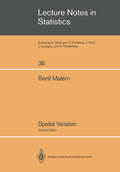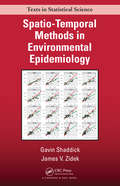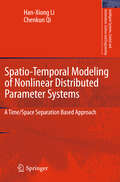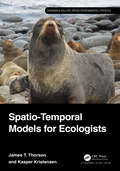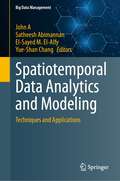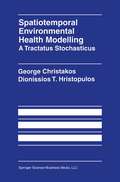- Table View
- List View
Spatial Variation (Lecture Notes in Statistics #36)
by B. MaternThis book was first published in 1960 as No. 5 of Volume 49 of Reports of the Forest Research Institute of Sweden. It was at the same time a doctor's thesis in mathematical statistics at Stockholm University. In the second edition, a number of misprints and other errors have been corrected. An author index and a subject index have been added. Finally, a new postscript comments on the later development of the subjects treated in the book. BERTIL MATERN March r¢6 Acknowledgements The completion of this thesis was facilitated through the generous assist ance of several persons and institutions. I would wish to express my sincere gratitude to my teacher, Professor HARALD CRAMtR, now chancellor of the Swedish universities, for his valuable help and encouragement. Sincere thanks are also offered to Professor ULF GRENANDER for kindly reading the first version of the manuscript and giving valuable advice. The thesis has been prepared during two widely separated periods. A preliminary draft of Ch. 2 was written in 1948, whereas the remaining parts were completed in 1959-1960. The work originates from problems which I discussed in a publication in 1947. The problems were assigned to me by Professor MANFRED NASLUND, former head of the Swedish Forest Research Institute, now governor of the province Norrbotten. It is a pleasure to acknowledge my gratefulness to Professor Naslund for his un remitting encouragement and interest in my work.
Spatio-Temporal Data Streams (SpringerBriefs in Computer Science)
by Zdravko GalićThis SpringerBrief presents the fundamental concepts of a specialized class of data stream, spatio-temporal data streams, and demonstrates their distributed processing using Big Data frameworks and platforms. It explores a consistent framework which facilitates a thorough understanding of all different facets of the technology, from basic definitions to state-of-the-art techniques. Key topics include spatio-temporal continuous queries, distributed stream processing, SQL-like language embedding, and trajectory stream clustering. Over the course of the book, the reader will become familiar with spatio-temporal data streams management and data flow processing, which enables the analysis of huge volumes of location-aware continuous data streams. Applications range from mobile object tracking and real-time intelligent transportation systems to traffic monitoring and complex event processing. Spatio-Temporal Data Streams is a valuable resource for researchers studying spatio-temporal data streams and Big Data analytics, as well as data engineers and data scientists solving data management and analytics problems associated with this class of data.
Spatio-temporal Design: Advances in Efficient Data Acquisition (Statistics in Practice)
by Jorge Mateu Werner G. M LlerA state-of-the-art presentation of optimum spatio-temporal sampling design - bridging classic ideas with modern statistical modeling concepts and the latest computational methods. Spatio-temporal Design presents a comprehensive state-of-the-art presentation combining both classical and modern treatments of network design and planning for spatial and spatio-temporal data acquisition. A common problem set is interwoven throughout the chapters, providing various perspectives to illustrate a complete insight to the problem at hand. Motivated by the high demand for statistical analysis of data that takes spatial and spatio-temporal information into account, this book incorporates ideas from the areas of time series, spatial statistics and stochastic processes, and combines them to discuss optimum spatio-temporal sampling design. Spatio-temporal Design: Advances in Efficient Data Acquisition: Provides an up-to-date account of how to collect space-time data for monitoring, with a focus on statistical aspects and the latest computational methods Discusses basic methods and distinguishes between design and model-based approaches to collecting space-time data. Features model-based frequentist design for univariate and multivariate geostatistics, and second-phase spatial sampling. Integrates common data examples and case studies throughout the book in order to demonstrate the different approaches and their integration. Includes real data sets, data generating mechanisms and simulation scenarios. Accompanied by a supporting website featuring R code. Spatio-temporal Design presents an excellent book for graduate level students as well as a valuable reference for researchers and practitioners in the fields of applied mathematics, engineering, and the environmental and health sciences.
Spatio-temporal Design: Advances in Efficient Data Acquisition (Statistics in Practice)
by Jorge Mateu Werner G. M Uuml EllerA state-of-the-art presentation of optimum spatio-temporal sampling design - bridging classic ideas with modern statistical modeling concepts and the latest computational methods. Spatio-temporal Design presents a comprehensive state-of-the-art presentation combining both classical and modern treatments of network design and planning for spatial and spatio-temporal data acquisition. A common problem set is interwoven throughout the chapters, providing various perspectives to illustrate a complete insight to the problem at hand. Motivated by the high demand for statistical analysis of data that takes spatial and spatio-temporal information into account, this book incorporates ideas from the areas of time series, spatial statistics and stochastic processes, and combines them to discuss optimum spatio-temporal sampling design. Spatio-temporal Design: Advances in Efficient Data Acquisition: Provides an up-to-date account of how to collect space-time data for monitoring, with a focus on statistical aspects and the latest computational methods Discusses basic methods and distinguishes between design and model-based approaches to collecting space-time data. Features model-based frequentist design for univariate and multivariate geostatistics, and second-phase spatial sampling. Integrates common data examples and case studies throughout the book in order to demonstrate the different approaches and their integration. Includes real data sets, data generating mechanisms and simulation scenarios. Accompanied by a supporting website featuring R code. Spatio-temporal Design presents an excellent book for graduate level students as well as a valuable reference for researchers and practitioners in the fields of applied mathematics, engineering, and the environmental and health sciences.
Spatio-Temporal Methods in Environmental Epidemiology (Chapman And Hall/crc Texts In Statistical Science Ser.)
by Gavin ShaddickTeaches Students How to Perform Spatio-Temporal Analyses within Epidemiological StudiesSpatio-Temporal Methods in Environmental Epidemiology is the first book of its kind to specifically address the interface between environmental epidemiology and spatio-temporal modeling. In response to the growing need for collaboration between statisticians and
Spatio-Temporal Modeling of Nonlinear Distributed Parameter Systems: A Time/Space Separation Based Approach (Intelligent Systems, Control and Automation: Science and Engineering #50)
by Han-Xiong Li Chenkun QiThe purpose of this volume is to provide a brief review of the previous work on model reduction and identifi cation of distributed parameter systems (DPS), and develop new spatio-temporal models and their relevant identifi cation approaches.In this book, a systematic overview and classifi cation on the modeling of DPS is presented fi rst, which includes model reduction, parameter estimation and system identifi cation. Next, a class of block-oriented nonlinear systems in traditional lumped parameter systems (LPS) is extended to DPS, which results in the spatio-temporal Wiener and Hammerstein systems and their identifi cation methods. Then, the traditional Volterra model is extended to DPS, which results in the spatio-temporal Volterra model and its identification algorithm. All these methods are based on linear time/space separation. Sometimes, the nonlinear time/space separation can play a better role in modeling of very complex processes.Thus, a nonlinear time/space separation based neural modeling is also presented for a class of DPS with more complicated dynamics. Finally, all these modeling approaches are successfully applied to industrial thermal processes, including a catalytic rod, a packed-bed reactor and a snap curing oven. The work is presented giving a unifi ed view from time/space separation. The book also illustrates applications to thermal processes in the electronics packaging and chemical industry. This volume assumes a basic knowledge about distributed parameter systems, system modeling and identifi cation. It is intended for researchers, graduate students and engineers interested in distributed parameter systems, nonlinear systems, and process modeling and control.
Spatio-Temporal Models for Ecologists (Chapman & Hall/CRC Applied Environmental Statistics)
by James Thorson Kasper KristensenEcological dynamics are tremendously complicated and are studied at a variety of spatial and temporal scales. Ecologists often simplify analysis by describing changes in density of individuals across a landscape, and statistical methods are advancing rapidly for studying spatio-temporal dynamics. However, spatio-temporal statistics is often presented using a set of principles that may seem very distant from ecological theory or practice. This book seeks to introduce a minimal set of principles and numerical techniques for spatio-temporal statistics that can be used to implement a wide range of real-world ecological analyses regarding animal movement, population dynamics, community composition, causal attribution, and spatial dynamics. We provide a step-by-step illustration of techniques that combine core spatial-analysis packages in R with low-level computation using Template Model Builder. Techniques are showcased using real-world data from varied ecological systems, providing a toolset for hierarchical modelling of spatio-temporal processes. Spatio-Temporal Models for Ecologists is meant for graduate level students, alongside applied and academic ecologists.Key Features: Foundational ecological principles and analyses Thoughtful and thorough ecological examples Analyses conducted using a minimal toolbox and fast computation Code using R and TMB included in the book and available online
Spatio-Temporal Models for Ecologists (Chapman & Hall/CRC Applied Environmental Statistics)
by James Thorson Kasper KristensenEcological dynamics are tremendously complicated and are studied at a variety of spatial and temporal scales. Ecologists often simplify analysis by describing changes in density of individuals across a landscape, and statistical methods are advancing rapidly for studying spatio-temporal dynamics. However, spatio-temporal statistics is often presented using a set of principles that may seem very distant from ecological theory or practice. This book seeks to introduce a minimal set of principles and numerical techniques for spatio-temporal statistics that can be used to implement a wide range of real-world ecological analyses regarding animal movement, population dynamics, community composition, causal attribution, and spatial dynamics. We provide a step-by-step illustration of techniques that combine core spatial-analysis packages in R with low-level computation using Template Model Builder. Techniques are showcased using real-world data from varied ecological systems, providing a toolset for hierarchical modelling of spatio-temporal processes. Spatio-Temporal Models for Ecologists is meant for graduate level students, alongside applied and academic ecologists.Key Features: Foundational ecological principles and analyses Thoughtful and thorough ecological examples Analyses conducted using a minimal toolbox and fast computation Code using R and TMB included in the book and available online
Spatio-temporal Networks: Modeling and Algorithms (SpringerBriefs in Computer Science)
by Betsy George Sangho KimSpatio-temporal networks (STN)are spatial networks whose topology and/or attributes change with time. These are encountered in many critical areas of everyday life such as transportation networks, electric power distribution grids, and social networks of mobile users. STN modeling and computations raise significant challenges. The model must meet the conflicting requirements of simplicity and adequate support for efficient algorithms. Another challenge is to address the change in the semantics of common graph operations, such as, shortest path computation assuming different semantics, or when temporal dimension is added. Also paradigms (e.g. dynamic programming) used in algorithm design may be ineffective since their assumptions (e.g. stationary ranking of candidates) may be violated by the dynamic nature of STNs. In recent years, STNs have attracted attention in research. New representations have been proposed along with algorithms to perform key STN operations, while accounting for their time dependence. Designing a STN database would require the development of data models, query languages, and indexing methods to efficiently represent, query, store, and manage time-variant properties of the network. The purpose of Spatio-temporal Networks: Modeling and Algorithms is to explore this design at the conceptual, logical, and physical level. Models used to represent STNs are explored and analyzed. STN operations, with an emphasis on their altered semantics with the addition of temporal dimension, are also addressed.
Spatio-Temporal Statistics with R (Chapman & Hall/CRC The R Series)
by Christopher K. Wikle Andrew Zammit-Mangion Noel CressieThe world is becoming increasingly complex, with larger quantities of data available to be analyzed. It so happens that much of these "big data" that are available are spatio-temporal in nature, meaning that they can be indexed by their spatial locations and time stamps. Spatio-Temporal Statistics with R provides an accessible introduction to statistical analysis of spatio-temporal data, with hands-on applications of the statistical methods using R Labs found at the end of each chapter. The book: Gives a step-by-step approach to analyzing spatio-temporal data, starting with visualization, then statistical modelling, with an emphasis on hierarchical statistical models and basis function expansions, and finishing with model evaluation Provides a gradual entry to the methodological aspects of spatio-temporal statisticsProvides broad coverage of using R as well as "R Tips" throughout. Features detailed examples and applications in end-of-chapter Labs Features "Technical Notes" throughout to provide additional technical detail where relevant Supplemented by a website featuring the associated R package, data, reviews, errata, a discussion forum, and more The book fills a void in the literature and available software, providing a bridge for students and researchers alike who wish to learn the basics of spatio-temporal statistics. It is written in an informal style and functions as a down-to-earth introduction to the subject. Any reader familiar with calculus-based probability and statistics, and who is comfortable with basic matrix-algebra representations of statistical models, would find this book easy to follow. The goal is to give as many people as possible the tools and confidence to analyze spatio-temporal data.
Spatiotemporal Data Analysis
by Gidon EshelA severe thunderstorm morphs into a tornado that cuts a swath of destruction through Oklahoma. How do we study the storm's mutation into a deadly twister? Avian flu cases are reported in China. How do we characterize the spread of the flu, potentially preventing an epidemic? The way to answer important questions like these is to analyze the spatial and temporal characteristics--origin, rates, and frequencies--of these phenomena. This comprehensive text introduces advanced undergraduate students, graduate students, and researchers to the statistical and algebraic methods used to analyze spatiotemporal data in a range of fields, including climate science, geophysics, ecology, astrophysics, and medicine. Gidon Eshel begins with a concise yet detailed primer on linear algebra, providing readers with the mathematical foundations needed for data analysis. He then fully explains the theory and methods for analyzing spatiotemporal data, guiding readers from the basics to the most advanced applications. This self-contained, practical guide to the analysis of multidimensional data sets features a wealth of real-world examples as well as sample homework exercises and suggested exams.
Spatiotemporal Data Analysis
by Gidon EshelA severe thunderstorm morphs into a tornado that cuts a swath of destruction through Oklahoma. How do we study the storm's mutation into a deadly twister? Avian flu cases are reported in China. How do we characterize the spread of the flu, potentially preventing an epidemic? The way to answer important questions like these is to analyze the spatial and temporal characteristics--origin, rates, and frequencies--of these phenomena. This comprehensive text introduces advanced undergraduate students, graduate students, and researchers to the statistical and algebraic methods used to analyze spatiotemporal data in a range of fields, including climate science, geophysics, ecology, astrophysics, and medicine. Gidon Eshel begins with a concise yet detailed primer on linear algebra, providing readers with the mathematical foundations needed for data analysis. He then fully explains the theory and methods for analyzing spatiotemporal data, guiding readers from the basics to the most advanced applications. This self-contained, practical guide to the analysis of multidimensional data sets features a wealth of real-world examples as well as sample homework exercises and suggested exams.
Spatiotemporal Data Analytics and Modeling: Techniques and Applications (Big Data Management)
by John A Satheesh Abimannan El-Sayed M. El-Alfy Yue-Shan ChangWith the growing advances in technology and transformation to digital services, the world is becoming more connected and more complex. Huge heterogeneous data are generated at rapid speed from various types of sensors. Augmented with artificial intelligence and machine learning and internet of things, latent relations, and new insights can be captured helping in optimizing plans and resource utilization, improving infrastructure, and enhancing quality of services. A “spatial data management system” is a way to take care of data that has something to do with space. This could include data such as maps, satellite images, and GPS data. A temporal data management system is a system designed to manage data that has a temporal component. This could include data such as weather data, financial data, and social media data. Some advanced techniques used in spatial and temporal data management systems include geospatial indexing for efficient querying and retrieval of location-based data, time-series analysis for understanding and predicting temporal patterns in datasets like weather or financial trends, machine learning algorithms for uncovering hidden patterns and correlations in large and complex datasets, and integration with Internet of Things (IoT) technologies for real-time data collection and analysis. These techniques, augmented with artificial intelligence, enable the extraction of latent relations and insights, thereby optimizing plans, improving infrastructure, and enhancing the quality of services. This book provides essential technical knowledge, best practices, and case studies on the state-of-the-art techniques of artificial intelligence and machine learning for spatiotemporal data analysis and modeling. The book is composed of several chapters written by experts in their fields and focusing on several applications including recommendation systems, big data analytics, supply chains and e-commerce, energy consumption and demand forecasting,and traffic and environmental monitoring. It can be used as academic reference at graduate level or by professionals in science and engineering related fields such as data science and engineering, big data analytics and mining, artificial intelligence, machine learning and deep learning, cloud computing, and internet of things.
Spatiotemporal Environmental Health Modelling: A Tractatus Stochasticus
by George Christakos Dionissios HristopulosSpatiotemporal Environmental Health Modelling: A Tractatus Stochasticus provides a holistic, conceptual and quantitative framework for Environmental Health Modelling in space-time. The holistic framework integrates two aspects of Environmental Health Science that have been previously treated separately: the environmental aspect, which involves the natural processes that bring about human exposure to harmful substances; and the health aspect, which focuses on the interactions of these substances with the human body. Some of the fundamental issues addressed in this work include variability, scale, uncertainty, and space-time connectivity. These topics are important in the characterization of natural systems and health processes. Spatiotemporal Environmental Health Modelling: A Tractatus Stochasticus explains why modern stochastics is the appropriate mechanical vehicle for addressing such issues in a rigorous way. In particular, modern stochastics incorporates concepts and methods from probability, classical statistics, geostatistics, statistical mechanics and field theory. The authors present a synthetic view of environmental health that embraces all of the various components and focuses on their mutual interactions. Spatiotemporal Environmental Health Modeling: A Tractatus Stochasticus includes new material on Bayesian maximum entropy estimation techniques and space-time random field estimation methods. The authors show why these methods have clear advantages over the classical geostatistical estimation procedures and how they can be used to provide accurate space-time maps of environmental health processes. Also included are expositions of diagrammatic perturbation and renormalization group analysis, which have not been previously discussed within the context of Environmental Health. Finally, the authors present stochastic indicators that can be used for large-scale characterization of contamination and investigations of health effects at the microscopic level. This book will be a useful reference to both researchers and practitioners of Environmental Health Sciences. It will appeal specifically to environmental engineers, geographers, geostatisticians, earth scientists, toxicologists, epidemiologists, pharmacologists, applied mathematicians, physicists and biologists.
Spatiotemporal Modeling of Cancer Immunotherapy: Partial Differential Equation Analysis in R
by William E. SchiesserThe focus of this book is a detailed discussion of a dual cancer vaccine (CV)-immune checkpoint inhibitor (ICI) mathematical model formulated as a system of partial differential equations (PDEs) defining the spatiotemporal distribution of cells and biochemicals during tumor growth.A computer implementation of the model is discussed in detail for the quantitative evaluation of CV-ICI therapy. The coding (programming) consists of a series of routines in R, a quality, open-source scientific computing system that is readily available from the internet. The routines are based on the method of lines (MOL), a general PDE algorithm that can be executed on modest computers within the basic R system. The reader can download and use the routines to confirm the model solutions reported in the book, then experiment with the model by varying the parameters and modifying/extending the equations, and even studying alternative models with the PDE methodology demonstrated by the CV-ICI model.Spatiotemporal Modeling of Cancer Immunotherapy: Partial Differential Equation Analysis in R facilitates the use of the model, and more generally, computer- based analysis of cancer immunotherapy mathematical models, as a step toward the development and quantitative evaluation of the immunotherapy approach to the treatment of cancer.
SPC and Continuous Improvement
by Mal OwenThere is no doubt that quality has become a major feature in the survival plan of organisations. With diminishing markets resulting from improved competitive performance and the associated factor of single-sourcing arrangements by the major organisations, it is clear that unless there is a commitment to change, organisations will lose their competitive edge. This will unfortunately mean elim ination and the resultant harsh realities that come with it for the employees. It has been said on many platforms that unemployment is not inevitable. Those organisations which recognise the requirements for survival know that quality, and its association with customer satisfaction, is now a key issue. Survival programmes based on quality improvement require an unrelenting com mitment to include everyone, from the Managing Director down, in an ongoing, never-ending involvement based on monitoring, and improving, all our activities. These Total Quality Management (TOM) programmes, whatever their specific nature, have a common theme of measuring and then improving. This text describes the philosophy and techniques of one type of involvement programme-Statistical Process Control (SPC). The material to follow suggests that SPC is a major element of any programme and, if properly applied, could be a complete programme in itself. Measuring and improving means that data must be collected, used, understood, interpreted and analysed, and thereby lies the difficulty.
SPC Simplified for Services: Practical tools for continuous quality improvement
by Davida Amsden Howard Butler Robert AmsdenIn this book, we talk about many of the tools and techniques of qual ity. These tools are easy to learn. So you can better see where the tools of quality fit in your service business, we will first talk about what it takes to become a quality organization. THE NEED In many manufacturing industries worldwide, quality is a major strat egy for gaining the competitive edge. Quality in the Japanese auto indus try, for example, means the quality of everything the company does as well as the quality of the product itself. This includes the quality of sales; of market research to find out what the customer wants, needs, and ex pects; of new product development; of ordering processes; of billing; of service of the product; etc. What does this have to do with service organizations? Until recently, the really tough competition from abroad, especially from Japan, has been in manufacturing. Competition is now growing in service industries as well. Any company, whether foreign or domestic, that learns the ideas and tools of quality and practices quality management will become a se rious competitive threat to your company. Some examples may help you see the seriousness of your situation.
SPDE in Hydrodynamics: Lectures given at the C.I.M.E. Summer School held in Cetraro, Italy, August 29 - September 3, 2005 (Lecture Notes in Mathematics #1942)
by Sergio Albeverio Franco Flandoli Yakov G. SinaiOf the three lecture courses making up the CIME summer school on Fluid Dynamics at Cetraro in 2005 reflected in this volume, the first, due to Sergio Albeverio describes deterministic and stochastic models of hydrodynamics. In the second course, Franco Flandoli starts from 3D Navier-Stokes equations and ends with turbulence. Finally, Yakov Sinai, in the 3rd course, describes some rigorous mathematical results for multidimensional Navier-Stokes systems and some recent results on the one-dimensional Burgers equation with random forcing.
Spear Operators Between Banach Spaces (Lecture Notes in Mathematics #2205)
by Vladimir Kadets Miguel Martín Javier Merí Antonio PérezThis monograph is devoted to the study of spear operators, that is, bounded linear operators $G$ between Banach spaces $X$ and $Y$ satisfying that for every other bounded linear operator $T:X\longrightarrow Y$ there exists a modulus-one scalar $\omega$ such that$\|G + \omega\,T\|=1+ \|T\|$.This concept extends the properties of the identity operator in those Banach spaces having numerical index one. Many examples among classical spaces are provided, being one of them the Fourier transform on $L_1$. The relationships with the Radon-Nikodým property, with Asplund spaces and with the duality, and some isometric and isomorphic consequences are provided. Finally, Lipschitz operators satisfying the Lipschitz version of the equation above are studied. The book could be of interest to young researchers and specialists in functional analysis, in particular to those interested in Banach spaces and their geometry. It is essentially self-contained and only basic knowledge of functional analysis is needed.
Special Classes of Semigroups (Advances in Mathematics #1)
by A. NagyIn semigroup theory there are certain kinds of band decompositions, which are very useful in the study of the structure semigroups. There are a number of special semigroup classes in which these decompositions can be used very successfully. The book focuses attention on such classes of semigroups. Some of them are partially discussed in earlier books, but in the last thirty years new semigroup classes have appeared and a fairly large body of material has been published on them. The book provides a systematic review on this subject. The first chapter is an introduction. The remaining chapters are devoted to special semigroup classes. These are Putcha semigroups, commutative semigroups, weakly commutative semigroups, R-Commutative semigroups, conditionally commutative semigroups, RC-commutative semigroups, quasi commutative semigroups, medial semigroups, right commutative semigroups, externally commutative semigroups, E-m semigroups, WE-m semigroups, weakly exponential semigroups, (m,n)-commutative semigroups and n(2)-permutable semigroups. Audience: Students and researchers working in algebra and computer science.
Special Functions: An Introduction to the Classical Functions of Mathematical Physics
by Nico M. TemmeThis book gives an introduction to the classical, well-known special functions which play a role in mathematical physics, especially in boundary value problems. Calculus and complex function theory form the basis of the book and numerous formulas are given. Particular attention is given to asymptomatic and numerical aspects of special functions, with numerous references to recent literature provided.
Special Functions 2000: Current Perspective and Future Directions (NATO Science Series II: Mathematics, Physics and Chemistry #30)
by Joaquin Bustoz Mourad E. H. Ismail Sergei SuslovThe Advanced Study Institute brought together researchers in the main areas of special functions and applications to present recent developments in the theory, review the accomplishments of past decades, and chart directions for future research. Some of the topics covered are orthogonal polynomials and special functions in one and several variables, asymptotic, continued fractions, applications to number theory, combinatorics and mathematical physics, integrable systems, harmonic analysis and quantum groups, Painlevé classification.
Special Functions and Generalized Sturm-Liouville Problems (Frontiers in Mathematics)
by Mohammad Masjed-JameiThis book discusses theoretical and applied aspects of Sturm-Liouville theory and its generalization. It introduces and classifies generalized Sturm-Liouville problems in three different spaces: continuous, discrete, and q-discrete spaces, focusing on special functions that are solutions of a regular or singular Sturm-Liouville problem. Further, it describes the conditions under which the usual Sturm-Liouville problems with symmetric solutions can be extended to a larger class, particularly highlighting the solutions of generalized problems that result in new orthogonal sequences of continuous or discrete functions.Sturm-Liouville theory is central to problems in many areas, such as engineering, mathematics, physics, and biology. This accessibly written book on the topic is a valuable resource for a broad interdisciplinary readership, from novices to experts.
Special Functions and their Application
by Bipin Singh Koranga Sanjay Kumar Padaliya Vivek Kumar NautiyalSpecial functions are mathematical functions that have established names and notations due to their importance in mathematical analysis, functional analysis, geometry, physics, or other applications. This short text gives clear descriptions and explanations of the Gamma function, the Probability Integral and its related functions, Spherical Harmonics Theory, The Bessel function, Hermite polynomials and Laguerre polynomials. Each chapter finishes with a description of how the function is most commonly applied and a set of examples for the student to work through.
Special Functions and their Application
by Bipin Singh Koranga Sanjay Kumar Padaliya Vivek Kumar NautiyalSpecial functions are mathematical functions that have established names and notations due to their importance in mathematical analysis, functional analysis, geometry, physics, or other applications. This short text gives clear descriptions and explanations of the Gamma function, the Probability Integral and its related functions, Spherical Harmonics Theory, The Bessel function, Hermite polynomials and Laguerre polynomials. Each chapter finishes with a description of how the function is most commonly applied and a set of examples for the student to work through.
